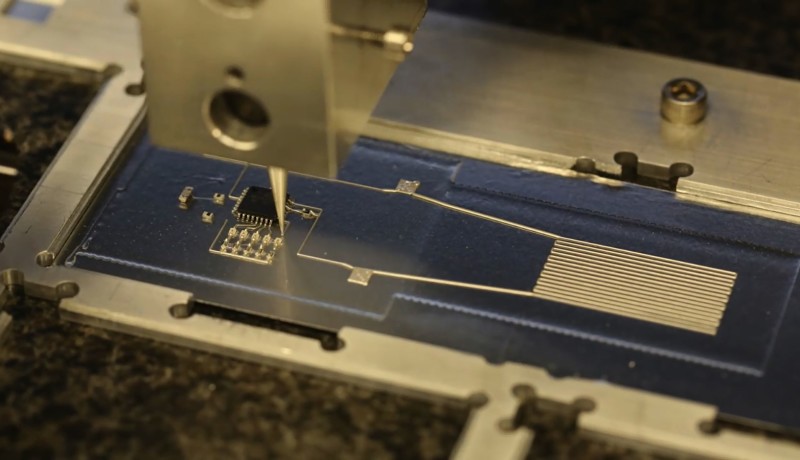Hybrid 3D printing creates stretchable & wearable circuits in a single process

A new method for digital design and printing of stretchable, flexible electronics has been developed by a team of researchers from the Air Force Research Laboratory and the Wyss Institute at Harvard University. Hybrid 3D printing, as the scientists call this technique, uses additive manufacturing to integrate soft, conductive inks with a material substrate to create stretchable, wearable electronic devices.
A new method for digital design and printing of stretchable, flexible electronics has been developed by a team of researchers from the Air Force Research Laboratory (AFRL) and the Wyss Institute at Harvard University. Hybrid 3D printing as the scientists call this technique uses additive manufacturing to integrate soft, conductive inks with a material substrate to create stretchable, wearable electronic devices.
Indeed, why print printed circuit boards to be assembled afterwards if you can print fully assembled and working circuits instead? Removing the limits of traditional electronics manufacturing opens up all sorts of new, exciting opportunities to merge structure and electronics.
The printer demonstrated by the researchers builds in a single process an entire stretchable circuit. Flexible, conductive silver-infused thermoplastic polyurethane traces are printed first, then the electronic components are pick-and-placed with the aid of a special “vacuum” printer nozzle. The devices created this way supported stretching by more than 30% while continuing to function.
As part of the study, the researchers printed sensors and placed electronic components onto a spandex sleeve able to respond to the movement of the wearer’s arm. They also created a pressure sensor for shoes, able to sense and monitor gait.
Photo courtesy of Harvard Wyss Institute
Indeed, why print printed circuit boards to be assembled afterwards if you can print fully assembled and working circuits instead? Removing the limits of traditional electronics manufacturing opens up all sorts of new, exciting opportunities to merge structure and electronics.
The printer demonstrated by the researchers builds in a single process an entire stretchable circuit. Flexible, conductive silver-infused thermoplastic polyurethane traces are printed first, then the electronic components are pick-and-placed with the aid of a special “vacuum” printer nozzle. The devices created this way supported stretching by more than 30% while continuing to function.
As part of the study, the researchers printed sensors and placed electronic components onto a spandex sleeve able to respond to the movement of the wearer’s arm. They also created a pressure sensor for shoes, able to sense and monitor gait.
Photo courtesy of Harvard Wyss Institute
